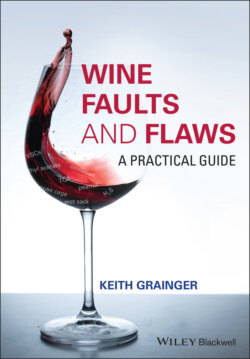Читать книгу Wine Faults and Flaws - Keith Grainger - Страница 31
1.10.3 Chemical Nature Faults 1.10.3.1 Examples of Chemical Faults
ОглавлениеChemical faults result from unwanted chemical changes in wine and may be due to internal or external factors. Two of the most common faults of chemical origin are chemical oxidation and, conversely, reduced aromas or reduction. There are thousands of chemical reactions that take place during the winemaking processes; some of these can result in the synthesis of compounds noted for their off‐odours and flavours, whilst others give simple changes, the impact of which may include immediate or rapid product deterioration.
Faults that are generally regarded as being primarily of a chemical nature include
Excessive acetaldehyde – see Chapter 5;
Chemical oxidation – see Chapter 5;
Reduced aromas/reduction – see Chapter 6;
Iron haze and copper haze – see Chapter 10;
Eucalyptol – 1,8‐cineole – see Chapter 12;
Smoke taint related compounds, including guaiacol, 4‐methyl‐guaiacol, 4‐methyl‐syringol, m‐cresol, o‐cresol, and p‐cresol – see Chapter 12;
Brown marmorated stink bug related compounds, including trans‐2‐decenal – see Chapter 13.
